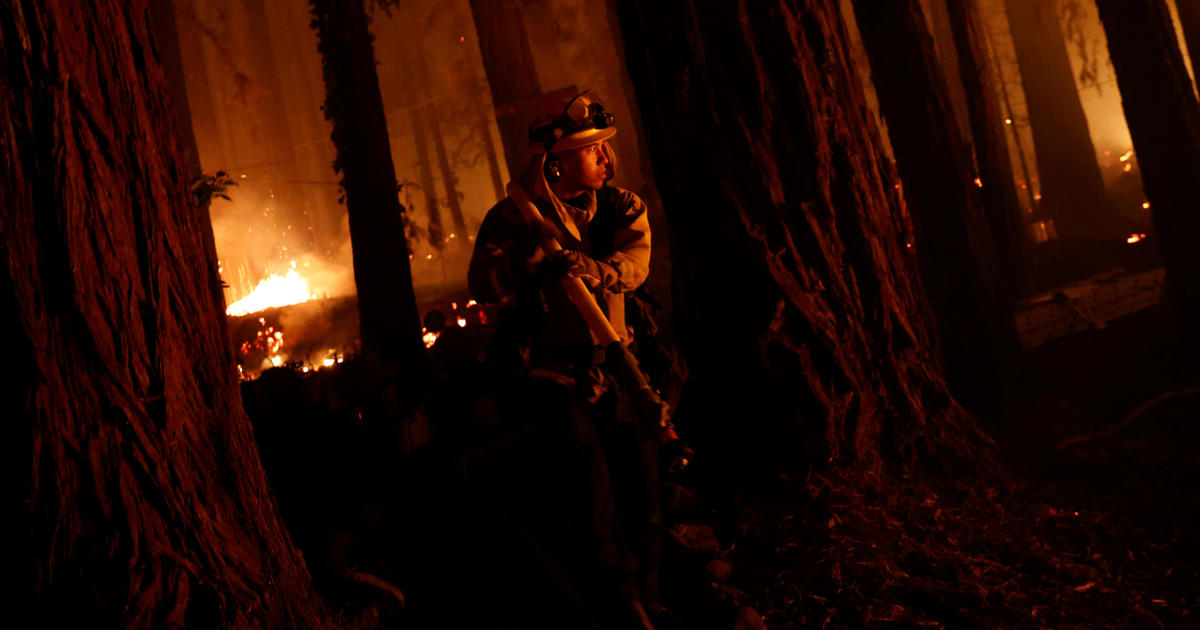Wildfires that blackened skies, took at least five lives and forced tens of thousands of people from their homes blazed across California on Thursday and early Friday, straining firefighting resources by the sheer vastness of the battle lines, CBS SF BayArea reports. Three major collections of fires — dozens in all – carved their way through forest, canyon country and rural areas in the San Francisco Bay Area and central California.
Tens of thousands of homes were threatened by flames driving through dense and bone-dry trees and brush. Many were sparked by lightning strikes from brief thunderstorms this week as a high-pressure area over the West brought a dangerous mix of triple-digit weather and monsoonal moisture pulled from the south.
Some fires doubled in size in 24 hours, fire officials said.
And while some evacuations were lifted in the town of Vacaville, between San Francisco and Sacramento, other areas increased their evacuation sizes.
The University of California, Santa Cruz was evacuated. A new fire burning near Yosemite National Park also prompted evacuations.
Wildfire near #Yosemite now 600 acres. Evacuation Orders in Groveland, Big Oak Flat, Mocassin. HWY 120 closed. pic.twitter.com/I3OnqY588r
— stevelarge (@largesteven) August 21, 2020
Santa Cruz itself, a central coast city of 65,000, wasn’t affected but Mayor Justin Cummings urged residents Thursday evening to be prepared to evacuate if necessary by gassing up and packing important documents, medicines and other belongings.
“Prepare early so that you are ready to go at a moment’s notice,” Cummings wrote.
Although the temperatures were expected to ease slightly Friday, they were expected to be hot enough that firefighters couldn’t count on cool evening air to aid them. Erratic winds also could drive the fires unpredictably in multiple directions, state fire officials said.
“There’s so much heat in these fires that they create their own wind … and they may blow in any direction, and very erratically,” said Daniel Berlant, an assistant deputy director with Cal Fire.
Cal Fire spokesman Dan Olson said there are concerns that some people are trying to organize through social media to create volunteer brigades and fight the fire themselves.
“The dangers out there to their own lives outweigh anything they can accomplish,” he said. “They’re putting their lives in jeopardy.”
Gov. Gavin Newsom addressed the wildfires Thursday in a last-minute video recorded for the Democratic National Convention.
“If you are in denial about climate change, come to California,” he said.
Winds gusting to 20 mph over ridge tops could challenge the overnight firefight in Santa Cruz and San Mateo counties, said the incident commander, Cal Fire assistant chief Billy See.
“This country likes to burn at night, more so than during the day and that’s because of the wind patterns,” he said.
Nearly 50,000 people were ordered evacuated in those counties.
The ferocity of the fires was astonishing so early in the fire season, which historically has seen the largest and deadliest blazes when Santa Ana winds begin to blow in the next two months.
Berlant said three civilians had died in Napa County and one in neighboring Solano County since the fires began. He didn’t have details but Solano County Sheriff Thomas A. Ferrara reported the death of a male resident there.
It wasn’t immediately clear whether the fatalities included a Pacific Gas & Electric utility worker who was found dead Wednesday in a vehicle in the Vacaville area.
Also, in central California, a pilot on a water-dropping mission in western Fresno County died Wednesday morning when his helicopter crashed.
At least two other people were missing and more than 30 civilians and firefighters have been injured, authorities said.
Smoke and ash billowing from the fires also fouled the air throughout the scenic central coast and San Francisco.
The fires have destroyed at least 175 buildings, including homes, and threatened tens of thousands more.
Cal Fire firefighter Anthony Quiroz carries a hose as he defends a home during the CZU Lightning Complex Fire in Boulder Creek, California, on August 21, 2020.
STEPHEN LAM / REUTERS
More than 10,000 firefighters were on the front lines. Some 3,000 firefighters had arrived in the past 24 hours, along with hundreds of fire engines from neighboring states, and National Guard troops that were staffing hand crews and flying helicopters, Berlant said.
Some C-130 military aircraft also had been outfitted as air tankers, Berlant added.
More firefighters were sent to battle the complex of fires in Santa Cruz and San Mateo counties but “it’s still not enough,” See said.
“We’re still drastically short for a fire of this size,” he said.
